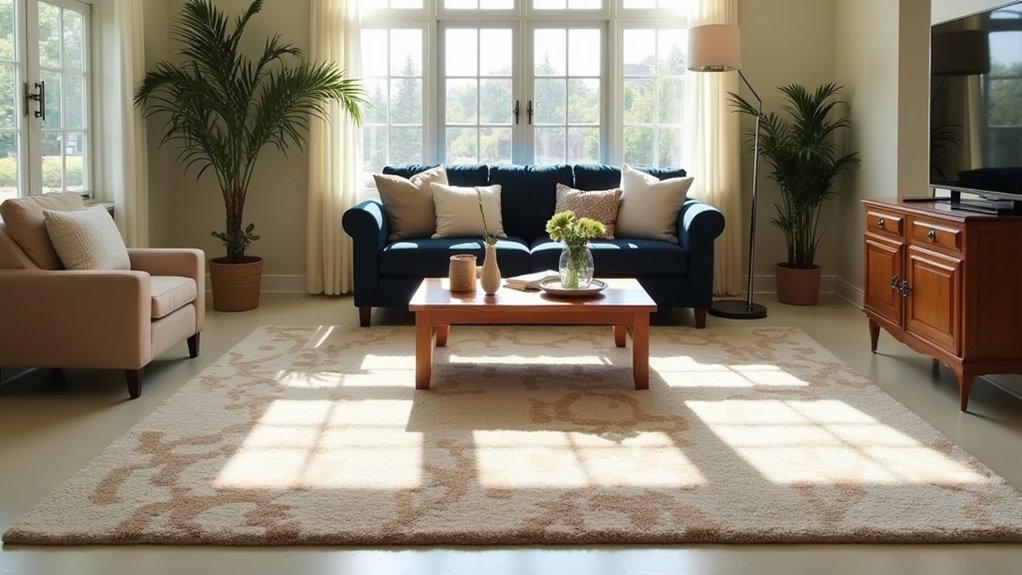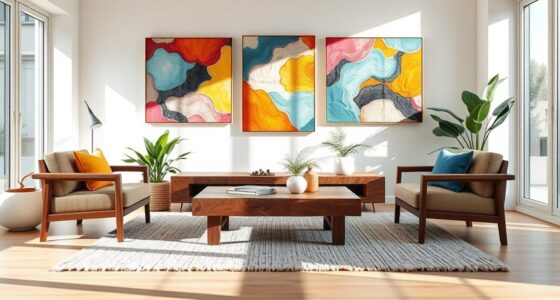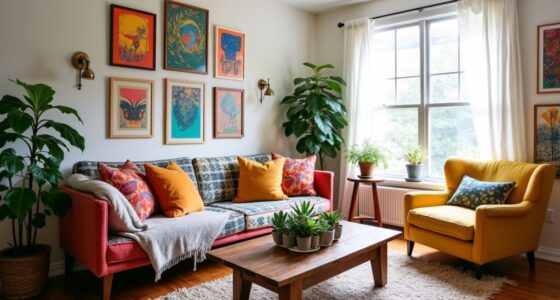Choosing the right size rug for your space is key to enhancing its layout and comfort. Start by measuring your area and furniture placement, ensuring the rug allows for at least 18-24 inches of visible flooring. For living rooms, opt for rugs sized 8′ x 10′ or 9′ x 12′, while dining areas need at least 12 inches of coverage beyond table edges. Get ready to explore more tips to find the perfect fit for your home!
Key Takeaways
- Measure your space and furniture layout to determine the ideal rug size, leaving 18-24 inches of visible flooring for balance.
- In living rooms, choose rugs sized 8′ x 10′ or 9′ x 12′ to ensure all front legs of furniture rest on the rug.
- For dining areas, rugs should extend at least 12 inches beyond the table edges to facilitate chair movement.
- In bedrooms, ensure the rug extends at least 24 inches beyond the bed on all sides for optimal coverage and comfort.
- Use painter’s tape to visualize rug dimensions in your space before making a purchase to avoid costly mistakes.
Understanding Rug Size Importance
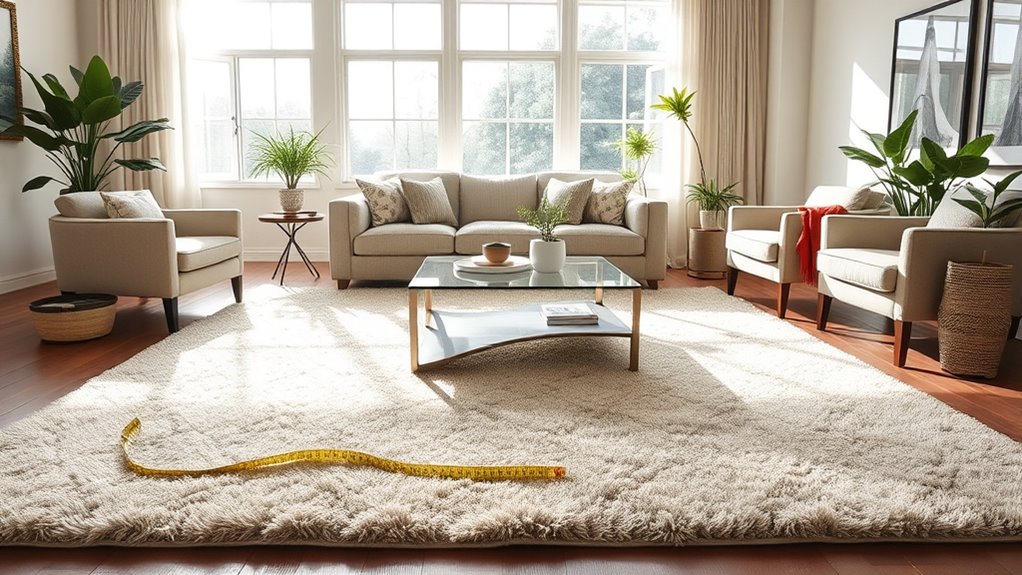
When you’re choosing a rug, understanding its size is essential because it can transform the feel of your space. The right rug size helps define conversation areas, creating a more cohesive and inviting layout.
An oversized rug can unify your furniture arrangement, making the room feel larger and more comfortable. On the flip side, a rug that’s too small can make your space look disjointed. Additionally, selecting a trustworthy source for rug measurements can help ensure you make the best choice for your area. Incorporating textured fabrics in your rug choice can also add warmth and comfort to your space. Furthermore, a well-chosen rug can serve as a focal point, drawing attention to your overall design style and enhancing the functional layout of the room.
Proper rug sizing also facilitates better traffic flow, ensuring movement around furniture isn’t hindered. Think about where you’ll place the rug and how it interacts with the surrounding elements. Additionally, consider how natural materials can enhance the overall aesthetic and comfort of your space.
Ultimately, selecting the right rug size enhances comfort underfoot, especially in areas where you spend a lot of time, like living rooms and bedrooms.
Measuring Your Space

Measuring your space accurately is vital for finding the perfect rug. Start by measuring the length and width of the area, accounting for furniture and walkways. Use painter’s tape to outline the desired rug dimensions, helping you visualize the space before purchasing. Additionally, consider how effective wall organization can complement your rug choice and enhance the overall room design. It’s important to remember that maintaining consistent routines can also contribute to a harmonious environment when decorating. Creating an organized oasis in your home is essential for a calm atmosphere. To further enhance the comfort of your space, think about incorporating cozy textiles that can work beautifully with your chosen rug.
| Tips for Measuring | Importance |
|---|---|
| Leave 18-24 inches of visible flooring | Creates a balanced look |
| Accommodate all front legs of furniture | Guarantees a cohesive arrangement |
| Extend rugs in dining areas by 24 inches | Allows chairs to move freely |
| Confirm measurements with a friend | Avoids costly mistakes |
Common Rug Size Guidelines
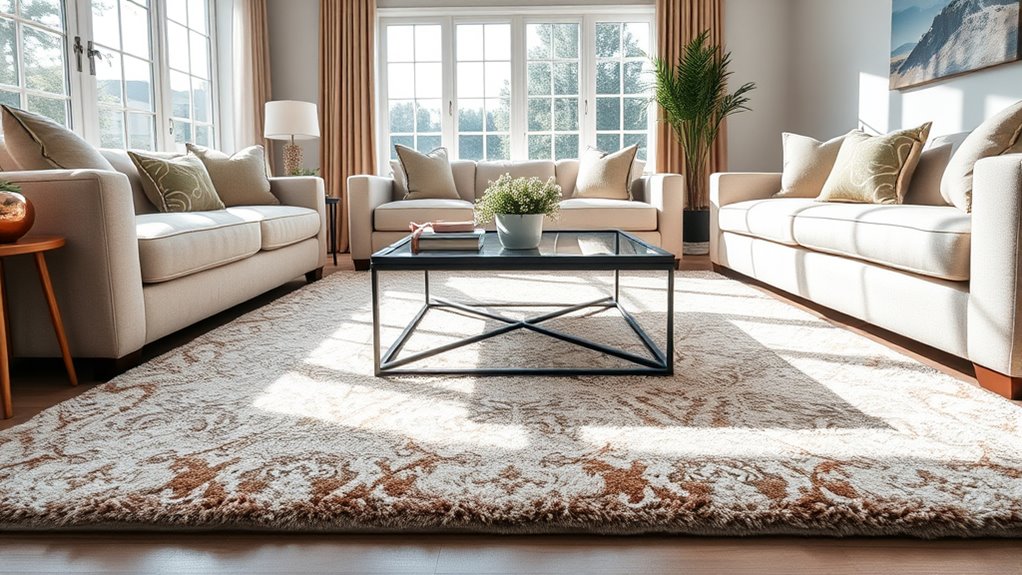
When choosing a rug, it’s essential to contemplate the specific dimensions for each room.
In the living room, you’ll want a size that allows furniture to rest comfortably on it, while dining areas require rugs that accommodate chair movement.
For bedrooms, aim for rugs that provide ample coverage around the bed for a cozy feel.
Living Room Dimensions
Choosing the right rug size for your living room can transform the space, creating a cozy and inviting atmosphere. For most living rooms, ideal rug sizes are 8′ x 10′ or 9′ x 12′. Make sure the rug is at least 6-8 inches wider than your sofa on both sides for a balanced look. All front legs of your living room furniture should ideally sit on the rug, fostering a cohesive seating area. If space is tight, you can settle for just the front legs.
To enhance the overall experience, consider how a well-placed rug can also reduce stress levels and promote a sense of calm in your living area. In addition, a mattress topper can help improve your overall comfort at home, making your living space even more inviting. Remember to keep the rug at least 2 feet away from walls to effectively define your conversation area. Avoid rugs smaller than 5′ x 8′, as they can make the room feel disjointed. Additionally, incorporating natural materials in your decor can enhance the overall ambiance of your living space. A well-chosen rug not only adds warmth but also complements the overall cozy spaces you create for family gatherings and relaxation.
Dining Area Requirements
To create a comfortable and functional dining area, your rug should extend at least 12 inches beyond the edges of the table. This guarantees there’s enough space for chairs on either side, allowing them to slide out easily. Common sizes for area rugs in dining rooms are 8′ x 10′ and 9′ x 12′, with the larger option preferred for bigger dining tables. Always maintain at least 36 inches from the edge of the dining table to the rug’s edge to prevent tripping hazards. Flatweave rugs are ideal, as they’re easy to clean and let chairs glide smoothly. Additionally, a rug that is high in nutrients can contribute to a welcoming atmosphere by enhancing the overall design of your dining space. A well-designed functional environment can elevate the dining experience and make mealtime more enjoyable. Remember, a well-sized rug ties the dining area together, creating a welcoming atmosphere. Furthermore, a neutral color palette can enhance the overall aesthetic of your dining space, complementing the rug and furniture. Incorporating effective preparation in your design choices can lead to a more harmonious dining area.
| Table Size | Recommended Rug Size | Minimum Space |
|---|---|---|
| 4-6 seats | 8′ x 10′ | 36 inches |
| 6-8 seats | 9′ x 12′ | 36 inches |
| 8+ seats | 10′ x 14′ | 36 inches |
Bedroom Placement Tips
A well-placed rug in your bedroom can enhance both comfort and style, just like in your dining area. To create a luxurious atmosphere, consider selecting a rug that complements the overall aesthetic of your space.
For a King bed, aim for a 9’ x 12’ rug, while an 8’ x 10’ rug fits perfectly under a Queen bed. It’s important to have at least 24 inches of rug extending beyond the sides and foot of the bed for a balanced look. Additionally, ensuring that the rug is placed in a well-ventilated area can improve air quality around your sleeping space. Incorporating moisture-resistant materials in your rug choice can further enhance durability and longevity.
In smaller spaces, a 5’ x 8’ rug can ground the bed while keeping some flooring visible. If you have a footboard, let it sit on the rug for a cohesive feel.
Also, consider placing small rugs on either side of the bed to boost symmetry and warmth, especially in larger bedroom layouts. Additionally, creating a home cinema experience can be enhanced by ensuring that your rug complements the overall aesthetic of the room.
Aesthetic Considerations
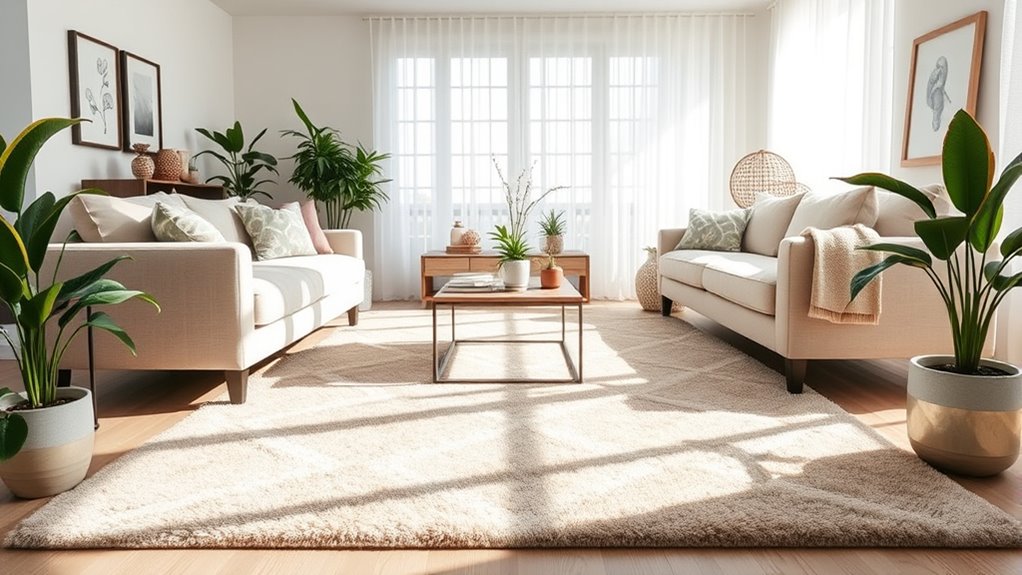
Rugs play an essential role in defining a room’s aesthetic, influencing both the visual appeal and the overall ambiance. When choosing your rug size, consider how patterns can draw attention or complement existing decor, tying your design elements together.
Light-colored rugs can create an illusion of a larger space, while darker options add warmth and coziness. The texture of your rug is also vital; plush rugs offer comfort, while flatweave styles bring a modern touch. Additionally, a well-chosen rug can enhance your space just as a backyard greenhouse can improve your gardening experience.
Additionally, think about contrast—selecting a rug that stands out against your flooring can help define the area, whereas matching colors create a seamless flow. Finally, confirm the scale of your rug’s pattern suits your room size, avoiding overwhelming or lost designs. Incorporating multifunctional furniture can further enhance your space, making it feel more cohesive and organized.
Living Room Rug Rules
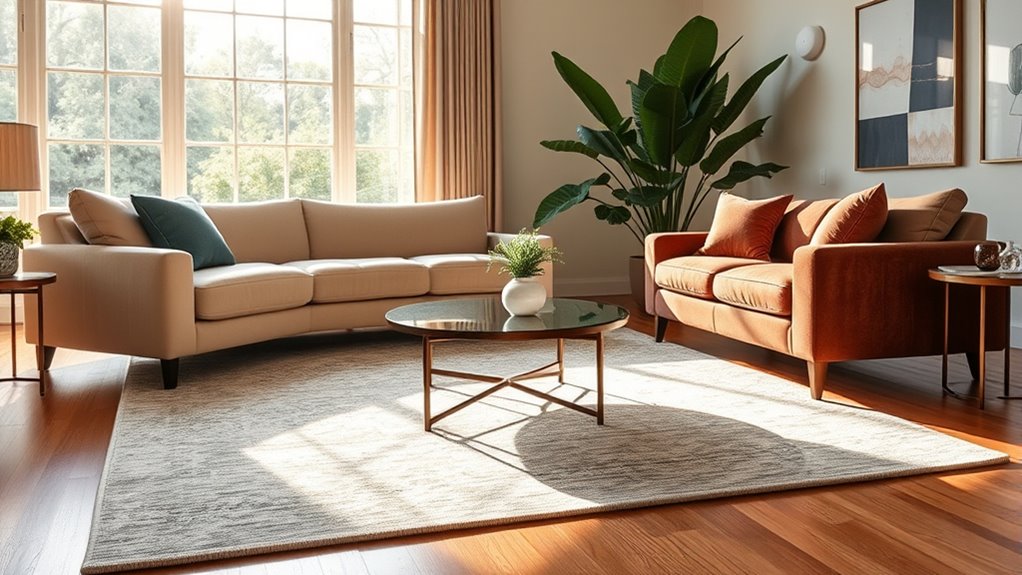
When selecting the perfect rug for your living room, consider how the right size can enhance the overall layout and feel of the space. Here are some essential rules to follow:
- Choose a rug size of at least 8’x10′ or 9’x12′, guaranteeing it’s 6-8 inches wider than your sofa on both sides.
- Make sure the rug runs the length of the sofa, allowing all front legs to rest on it for a cohesive look.
- Maintain a walkway space of 30-36 inches between large furniture pieces, or 18-24 inches if you’re tight on space.
- Always measure your seating area before shopping, opting for the closest size up to guarantee a comfortable fit.
Dining Room Rug Rules

Finding the right rug for your dining room can transform the space and enhance your dining experience. To guarantee your rug complements your area, follow these dining room rug rules:
| Rug Size | Description |
|---|---|
| 8’x10’ | Ideal for smaller tables, allowing chairs to pull out comfortably. |
| 9’x12’ | Best for larger tables, providing ample space for movement. |
| 12” | Keep this distance between the rug edges and the wall for balance. |
| 36” | Extend the rug at least this far from the table edge for easy chair movement. |
Choose flatweave rugs for practicality in managing spills while guaranteeing the rug fits well within the space, creating an inviting atmosphere.
Bedroom Rug Rules
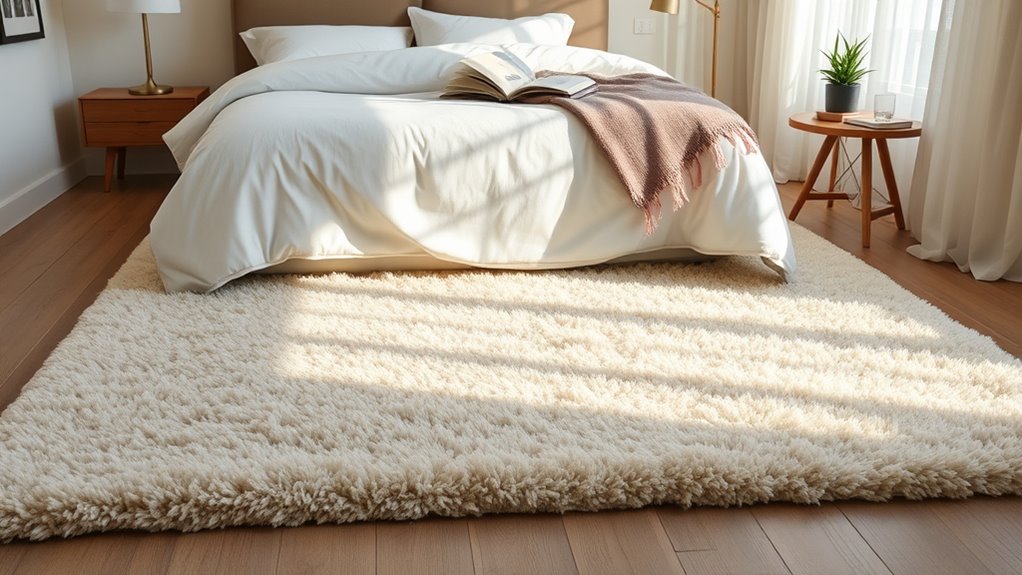
When choosing a rug for your bedroom, size matters—make sure it extends at least 24 inches beyond your bed for a balanced look.
Think about how the rug will be placed; it should support the footboard and provide a comfortable area for stepping out of bed.
A well-chosen rug not only enhances comfort but also ties your room together aesthetically.
Bed Size Considerations
Choosing the right rug size for your bed is essential for creating a harmonious bedroom atmosphere. Here are some key considerations to keep in mind:
- King Bed: Opt for a 9’x12’ rug to guarantee ample coverage around all sides.
- Queen Bed: An 8’x10’ rug works best, allowing at least 24 inches to extend beyond the sides and foot.
- Full Bed: A 6’x9’ rug offers a cozy feel while leaving some floor exposed.
- Twin Beds: Use a 5’x8’ rug, or place two smaller rugs on either side for a balanced look.
Placement and Arrangement
To achieve a well-balanced and inviting bedroom, it’s important to take into account the placement and arrangement of your rug.
For an ideal rug size, your bedroom rug should extend at least 24 inches on three sides of the bed. If you have a King bed, a 9’x12’ rug works best, while an 8’x10’ rug suits a Queen bed.
Make sure the legs of your chairs and footboard sit on the rug to create a cohesive look. To avoid a squished feel, make sure the rug is proportionate to the bed size and doesn’t leave excessive bare floor on either side.
Placing a rug under nightstands can also help stabilize your furniture and enhance the overall aesthetic.
Aesthetic Balance and Comfort
A well-placed rug can transform your bedroom into a serene retreat, providing both aesthetic balance and comfort.
To achieve this, consider these tips for your bedroom rug:
- Rug Size: For a King bed, opt for a 9′ x 12′ rug; for a Queen, choose an 8′ x 10′.
- Balanced Look: Guarantee the rug extends at least 24 inches on three sides of the bed for a cohesive feel.
- Coverage: Place footboard legs on the rug to enhance aesthetics and avoid a disjointed appearance.
- Smaller Rugs: Use smaller rugs on either side of the bed for added comfort and balance without overwhelming the space.
Hallway and Runner Rug Guidelines

Runners are a fantastic choice for hallways, offering both style and functionality. To guarantee safe passage, maintain a minimum gap of 3 inches between the runner rug and walls on each side.
Runners enhance hallway aesthetics and practicality, ensuring a safe passage with a 3-inch gap from the walls.
Instead of matching the exact length of the hallway, center the runner for a visually appealing layout. When placing furniture, let the front legs sit either on or off the runner to achieve a cohesive look.
Don’t forget to take into account the pile height; it should allow doors to open freely without obstruction. In long hallways, using two shorter runners can add interest, but be mindful of their placement to avoid split visuals.
With these guidelines, your hallway will feel inviting and stylish.
Frequently Asked Questions
How to Know What Size Rug to Get for a Room?
To know what size rug to get for a room, start by measuring your space accurately.
For living rooms, make certain the rug’s wider than your sofa and covers the front legs of your furniture.
In dining areas, let the rug extend beyond the table for easy chair movement.
In bedrooms, aim for a rug that provides a cozy landing area.
Finally, maintain some space between walls and the rug in hallways for a balanced look.
What Is the Rule of Thumb for Area Rugs?
When it comes to area rugs, a good rule of thumb is to place all front legs of your furniture on the rug. This creates a cohesive look and defines your conversation area.
For living rooms, aim for rugs measuring 8’x10’ or 9’x12’.
In dining rooms, let the rug extend at least 12″ beyond the table edges.
In bedrooms, guarantee it extends 24” on three sides of the bed for comfort.
What Is the 18 Inch Rule for Rugs?
When you’re laying down a rug, think of it like laying down the law—specifically, the 18-inch rule.
This guideline suggests leaving an 18-inch border of exposed flooring around your rug. It helps create balance in your space, especially in larger rooms, preventing that cramped feeling.
Plus, in dining areas, it guarantees chairs can slide out easily without snagging.
Stick to this rule, and you’ll achieve a cohesive and inviting look!
Is It Better to Have a Rug That’s Too Big or Too Small?
It’s generally better to choose a rug that’s too big rather than too small.
A larger rug can help create a more cohesive and inviting atmosphere, anchoring your furniture and making the space feel unified.
On the other hand, a small rug can make your area feel disjointed and cramped.
Conclusion
Choosing the right size rug can transform your space and make it feel complete. Did you know that a well-placed rug can increase a room’s perceived size by up to 15%? By measuring your area and following the guidelines for each room, you can select a rug that enhances both comfort and style. Remember, the right rug isn’t just about size; it’s about creating a welcoming atmosphere that reflects your personal taste. Happy decorating!
